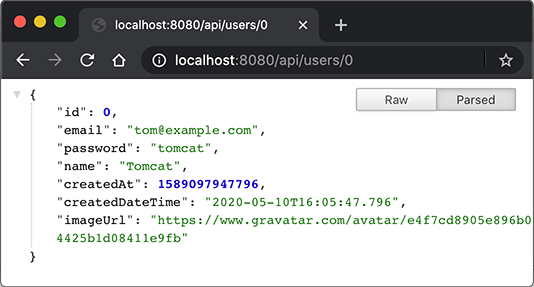使用REST
使用Spring MVC开发Web应用程序的主要工作就是编写Controller逻辑。在Web应用中,除了需要使用MVC给用户显示页面外,还有一类API接口,我们称之为REST,通常输入输出都是JSON,便于第三方调用或者使用页面JavaScript与之交互。
直接在Controller中处理JSON是可以的,因为Spring MVC的@GetMapping和@PostMapping都支持指定输入和输出的格式。如果我们想接收JSON,输出JSON,那么可以这样写:
@PostMapping(value = "/rest",
consumes = "application/json;charset=UTF-8",
produces = "application/json;charset=UTF-8")
@ResponseBody
public String rest(@RequestBody User user) {
return "{\"restSupport\":true}";
}
对应的Maven工程需要加入Jackson这个依赖:com.fasterxml.jackson.core:jackson-databind:2.14.0
注意到@PostMapping使用consumes声明能接收的类型,使用produces声明输出的类型,并且额外加了@ResponseBody表示返回的String无需额外处理,直接作为输出内容写入HttpServletResponse。输入的JSON则根据注解@RequestBody直接被Spring反序列化为User这个JavaBean。
使用curl命令测试一下:
$ curl -v -H "Content-Type: application/json" -d '{"email":"bob@example.com"}' http://localhost:8080/rest
> POST /rest HTTP/1.1
> Host: localhost:8080
> User-Agent: curl/7.64.1
> Accept: */*
> Content-Type: application/json
> Content-Length: 27
>
< HTTP/1.1 200
< Content-Type: application/json;charset=utf-8
< Content-Length: 20
< Date: Sun, 10 May 2020 09:56:01 GMT
<
{"restSupport":true}
输出正是我们写入的字符串。
直接用Spring的Controller配合一大堆注解写REST太麻烦了,因此,Spring还额外提供了一个@RestController注解,使用@RestController替代@Controller后,每个方法自动变成API接口方法。我们还是以实际代码举例,编写ApiController如下:
@RestController
@RequestMapping("/api")
public class ApiController {
@Autowired
UserService userService;
@GetMapping("/users")
public List<User> users() {
return userService.getUsers();
}
@GetMapping("/users/{id}")
public User user(@PathVariable("id") long id) {
return userService.getUserById(id);
}
@PostMapping("/signin")
public Map<String, Object> signin(@RequestBody SignInRequest signinRequest) {
try {
User user = userService.signin(signinRequest.email, signinRequest.password);
return Map.of("user", user);
} catch (Exception e) {
return Map.of("error", "SIGNIN_FAILED", "message", e.getMessage());
}
}
public static class SignInRequest {
public String email;
public String password;
}
}
编写REST接口只需要定义@RestController,然后,每个方法都是一个API接口,输入和输出只要能被Jackson序列化或反序列化为JSON就没有问题。我们用浏览器测试GET请求,可直接显示JSON响应:

要测试POST请求,可以用curl命令:
$ curl -v -H "Content-Type: application/json" -d '{"email":"bob@example.com","password":"bob123"}' http://localhost:8080/api/signin
> POST /api/signin HTTP/1.1
> Host: localhost:8080
> User-Agent: curl/7.64.1
> Accept: */*
> Content-Type: application/json
> Content-Length: 47
>
< HTTP/1.1 200
< Content-Type: application/json
< Transfer-Encoding: chunked
< Date: Sun, 10 May 2020 08:14:13 GMT
<
{"user":{"id":1,"email":"bob@example.com","password":"bob123","name":"Bob",...
注意观察上述JSON的输出,User能被正确地序列化为JSON,但暴露了password属性,这是我们不期望的。要避免输出password属性,可以把User复制到另一个UserBean对象,该对象只持有必要的属性,但这样做比较繁琐。另一种简单的方法是直接在User的password属性定义处加上@JsonIgnore表示完全忽略该属性:
public class User {
...
@JsonIgnore
public String getPassword() {
return password;
}
...
}
但是这样一来,如果写一个register(User user)方法,那么该方法的User对象也拿不到注册时用户传入的密码了。如果要允许输入password,但不允许输出password,即在JSON序列化和反序列化时,允许写属性,禁用读属性,可以更精细地控制如下:
public class User {
...
@JsonProperty(access = Access.WRITE_ONLY)
public String getPassword() {
return password;
}
...
}
同样的,可以使用@JsonProperty(access = Access.READ_ONLY)允许输出,不允许输入。
练习
使用REST实现API。
小结
使用@RestController可以方便地编写REST服务,Spring默认使用JSON作为输入和输出。
要控制序列化和反序列化,可以使用Jackson提供的@JsonIgnore和@JsonProperty注解。